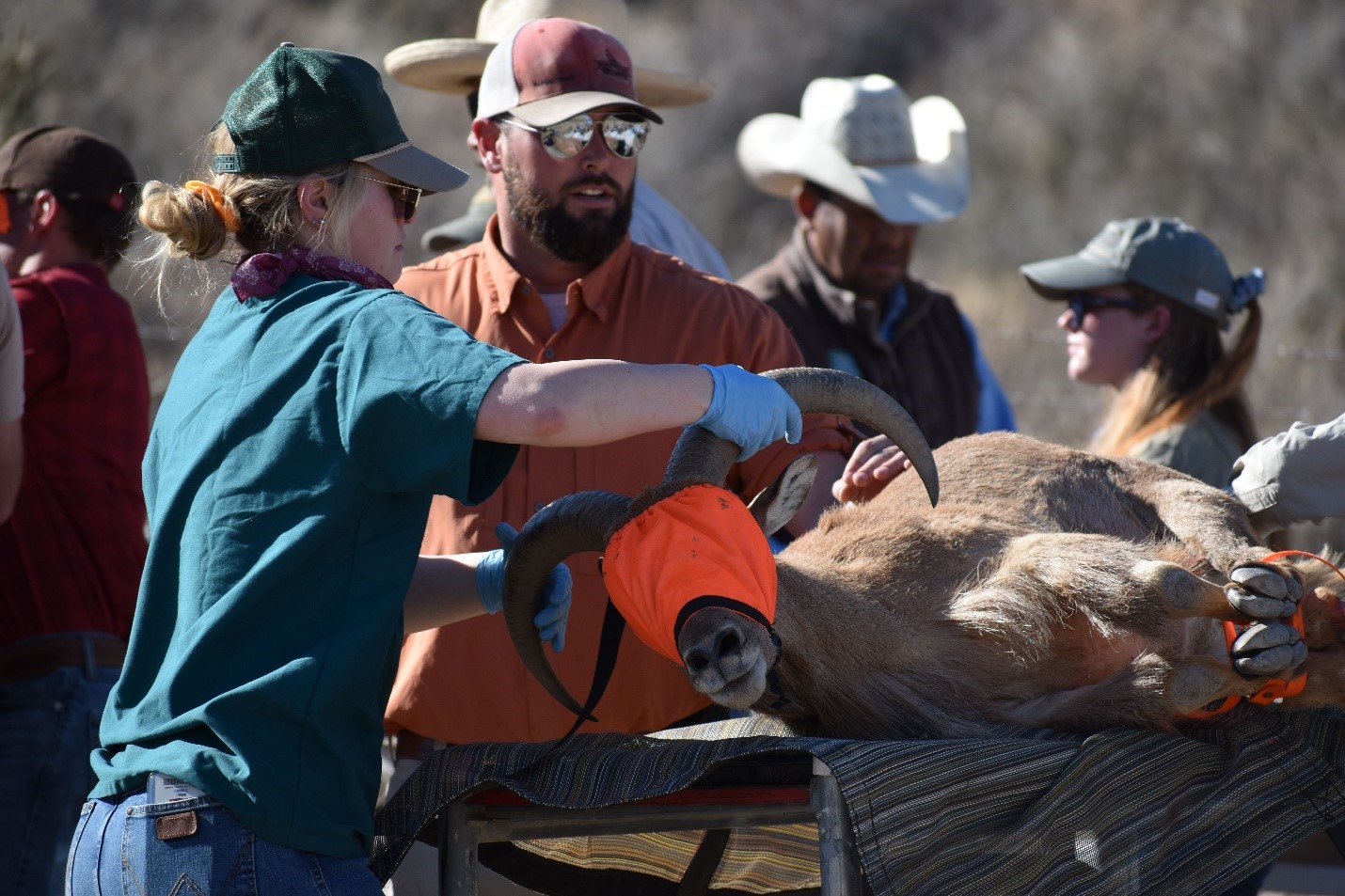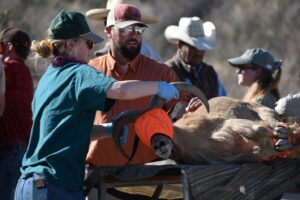
Borderlands Research Institute (BRI), housed at Sul Ross State University in Alpine, is partnering with Texas Parks and Wildlife Department (TPWD), Cesar Kleberg Wildlife Research Institute (CKWRI), Texas Tech University (TTU), and landowners to study long-term wildlife interactions among aoudad, elk, pronghorn, mule deer and desert bighorn sheep in West Texas.
Researchers convened over a three-week period beginning in February of this year to place satellite tracking collars on a total of 306 animals across the five species, for three research projects. These projects will provide information about how mule deer and aoudad compete for food and habitat, as well as what role aoudad play in disease transmission to desert bighorn.

Researchers placed tracking collars on a total of 306 animals in the mountains of West Texas this spring, including the aoudad pictured here.
“This study will expand on previous research that has been conducted by BRI graduate students,” said Dr. Justin French, who is assistant professor and big game specialist at the Borderlands Research Institute at Sul Ross State University. “While previous studies have been a snapshot in time, this more comprehensive project will provide information over several years that will demonstrate how manipulating aoudad population levels might affect native wildlife populations.”
Aoudad share similar habitat selection and foraging behavior as mule deer, which suggests that excessive aoudad numbers could produce competitive effects between the two species. Additionally, at high densities, aoudad are prone to infection of bacteria that cause acute pneumonia. While aoudad appear resilient to this bacterial pneumonia, it is a leading cause of die-offs in desert bighorn, presenting a major obstacle to ongoing bighorn restoration efforts.
The researchers placed 80 satellite tracking collars on mule deer and aoudad in the Quitman Mountains of southern Hudspeth County (20 on males and 20 on females of each species), and the same numbers in the Chinati Mountains of Presidio County. Both ranges offer high-quality habitat for aoudad, mule deer, and desert bighorn, and are also home to large aoudad populations.
The Quitman Mountains will serve as a control site, where researchers will observe interactions between the species without any major management intervention. However, researchers have partnered with several landowners to reduce aoudad numbers at the Chinati study site in year two of the study. Researchers will examine changes as the aoudad population rebounds in the subsequent two years. This will allow the team to identify thresholds in competition between mule deer and aoudad, providing guidance on how to balance long-term management goals for both species and mitigate habitat damage from too many aoudad.
Simultaneously, the team will monitor the prevalence of the pneumonia-causing bacteria in aoudad at both sites. They hope to see a decline in infection rates in the aoudad population at the Chinati study area after aoudad numbers are decreased. This would indicate that managers can curb pneumonia outbreaks with appropriate aoudad population management. This would be good news for the reestablishment of desert bighorn as aoudad now occupy most of the desert bighorn habitat in Texas.
Though opinions about them are divided, aoudad are here to stay in West Texas. Given how well-established their populations are throughout the region, eradication is logistically impossible. Further, aoudad hunting is a major part of the West Texas economy and the benefits to both ranchers and the broader community cannot be ignored.
With this study, BRI and research partners hope to provide managers with the information needed to set achievable goals to protect habitat and balance the needs of the native species that are living in an aoudad-occupied landscape.
“We appreciate the landowners who are working with us to learn more about how aoudad are impacting native Texas wildlife,” said French. “This research will result in several graduate thesis projects, and we look forward to sharing what we learn with area land managers.”
This study was made possible by the generous support of TPWD, the Wild Sheep Foundation, the Texas Bighorn Society, and the West Texas Chapter of Safari Club International.
